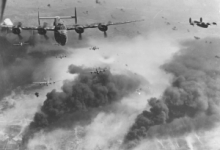Article
Known as the largest "total war," the Second World War, lasting between the years 1939 and 1945, was in some ways a continuation of the First World War, which had ended twenty years earlier but had left unresolved various European geopolitical disputes. World War II involved almost every part of the world, but the main fighting forces were the Axis forces of Germany, Italy, and Japan who opposed the Allied forces of France, Great Britain, and the United States. The war broke when Adolf Hitler, the German dictator, invaded Poland, and Great Britain and France intervened to assist Poland as it was trying to defend itself. After two years of intensive fighting in Europe, the Axis had the upper hand, and Hitler was able to continue his expansive attacks well beyond Poland into other countries in Eastern Europe.
After Japan attacked the United States in Pearl Harbor in 1941, the U.S. entered the war. Battles continued across the Pacific and the Atlantic oceans, North Africa, the Middle East, and parts of Asia. During 1944 and 1945 the Axis forces suffered severe defeats, and fighting in Europe ended on May 8, 1945, after the Western Allies' invaded Germany and captured Berlin. In July 1945, the U.S. dropped two atomic bombs in Japan, sealing the Allies' victory and officially ending the war. It is estimated that between 40 and 50 million deaths incurred during World War II, making it the deadliest war in world history.
"World War II Allied Forces Bombing of Romania, August 1, 1943" by Jerry J. Jostwick is licensed under Public Domain.
Manuscripts
References
Encyclopedia Britannica Online
N.d. World War II. http://www.britannica.com/EBchecked/topic/648813/World-War-II, accessed October 7, 2014.

